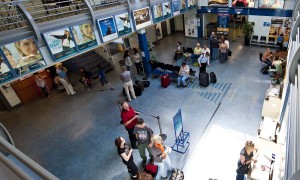
Waterford Airport: government aid specifically used to help meet the running costs of the Killowen facility will cease by 2024.
Under European Union (EU) rules by 2024, Government aid specifically used for the running costs of regional airports, including Waterford, will no longer be permitted, which poses the question: how shall the Killowen facility make itself self-sustainable? And, let’s face it, the clock is well and truly ticking on that front.
The key to such sustainability, in the opinion of Ireland South MEP Deirdre Clune (FG), lies in the long-awaited delivery of the runway extension, which would facilitate the landing of jet aircraft in the south east.
“Well, there’s no doubting that this one single development, which has been sought for so long, is the top priority item for the management and staff of the airport, along with regional stakeholders,” Ms Clune said in Brussels last Thursday.
“This has been holding Waterford back from getting major routes, such as a direct link to London, along with other European destinations” said Ms Clune during an interview with The Munster Express in the European Parliament.
Ms Clune (who sits on the European Parliament’s Transport Committee), recalling comments she’d previously made to this newspaper, added that a fund to support region-specific routes also remained an area which she feels ought to explored further in a Waterford context.
“And when Aer Lingus was sold to IAG, both (Finance Minister) Michael Noonan (Transport Minister) and Paschal Donohue mentioned at the time that there would be funding to support routes from regional airports…
“From a business point of view, if you’re selling Waterford and the south east as a region, then it is very important to have Waterford Airport in place as a viable, and, in time I would hope, a self-sustaining entity, with the key to that of course being the provision of the runway extension and all that would follow in its wake. Access is a vital component when it comes to encouraging and securing further investment, and when it comes to regional development, an air link is absolutely vital, in my view.”
Ms Clune recently mounted a successful bid to ensure that regional airports were included in a major EU report on the future of aviation throughout the 28 Member States.
“Europe is focusing too much on large airports like Dublin, London and Amsterdam,” she said.
“Yes, they are vital pieces of infrastructure but Waterford Airport is just as critical for Waterford and the surrounding areas.”
Ms Clune continued: “Small and regional airports like Waterford take the pressure off the larger hub airports. They drive tourism and foreign direct investment into parts of rural Ireland and increase general connectivity.
“Rather than being added on to policy documents as an afterthought, small and regional airports like Waterford should become pillars of the EU’s growth and Jobs Strategy.
“The EU Commission has approved the Government’s regional airports’ programme which will see over €40 million invested in Kerry, Waterford, Donegal and Knock airports over four years…but as we now know, these airports, under EU rules, have nine years to become self-sufficient.”
She stated: “44 per cent of Europe’s airports are loss making whilst 75 per cent of airports with less than one million passengers per year are loss making. We must not allow them to wither in a difficult European aviation market…
“In the US the airport industry benefits from more than $3 billion of direct public funding every year. In addition, security costs are publically financed.”
Deirdre Clune concluded: “For every 10,000 passengers that are brought through an airport, it has been shown to create 12 full time local jobs and numerous other indirect jobs.
“The Irish aviation industry supports 26,000 jobs directly and a further 16,000 in the supply chain. Ireland‘s tourism industry, which is hugely dependent on aviation, accounts for a further €5.3bn contribution to GDP and 180,000 jobs.”

